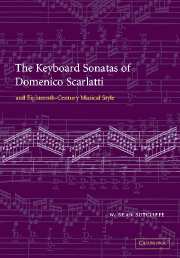2 - Panorama
Published online by Cambridge University Press: 22 September 2009
Summary
PLACE AND TREATMENT IN HISTORY
‘Writing about the sonatas’, says Jane Clark, is ‘a field so full of pitfalls that anyone willing to risk an opinion, however tentative, about the form, the chronology, the Spanish influence, the origins of the style or indeed anything else, is risking a great deal.’ The depth of uncertainty and, indeed, disagreement about what might in normal circumstances be basic givens – even about what the boundaries for enquiry are – is surely unmatched among famous composers of such relatively recent vintage. The wringing of hands has become more frequent with the progressive institutionalization of musicology in the twentieth century and the perceived need for accountable methodologies. Yet the uncertainties were felt before this, at least in the negative sense that so little of substance was written about Scarlatti. It would be wrong to suggest that Scarlatti had been neglected; the nineteenth century was certainly familiar with Domenico, especially through the work of pianist-arrangers. In 1898 Oskar Bie could write ‘Scarlatti is especially remarkable to us in the present day, in that he occupies the position of an early writer whose pieces still play a part, though a small one, in modern public concerts.’ While playing activity kept the composer alive during this time, scholarly activity had to wait. The first complete edition, by Alessandro Longo, appeared in 1906–10. The first monograph on Scarlatti, though, did not arrive until 1933. Perhaps not surprisingly, this honour fell to a German scholar, Walter Gerstenberg.
- Type
- Chapter
- Information
- Publisher: Cambridge University PressPrint publication year: 2003

